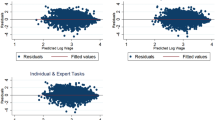Abstract
In this study incumbents from three different jobs were asked to rate lists of their job tasks on various constructs (e.g., time, importance) and then estimate the percentage of their job tasks (task coverage) included in the task list. Incumbents made these ratings under one of two conditions. In two instances, two months after making an initial task coverage rating for the entire list of tasks, the same incumbents were asked to estimate the task coverage of a reduced list of tasks (i.e., half to two-thirds of the tasks were removed from the list presented for rating). In a third instance one group of incumbents completed an entire inventory while a second group completed a reduced inventory. The average task coverage rating for the entire inventories were high (percent estimates ranging in the 80's–90's) and the average of the reduced inventories was much higher than expected (percent estimates in the 70's). It was concluded that incumbents and supervisors were not able to accurately estimate task coverage.
Similar content being viewed by others
REFERENCES
Arvey, R. D., Davis, G. A., McGowen, S. L., Dipboye, R. L. (1982). Potential sources of bias in job analytic processes. Academy of Management Journal, 25, 618–629.
Arvey, R. D., Passino, E. M., & Lounsbury, J. W. (1977). Job analysis results as influenced by sex of incumbent and sex of analyst. Journal of Applied Psychology, 62, 411–416.
Carpenter, J. B., Giorgia, M. J., & McFarland, B. P. (1975). Comparative analysis of the relative validity for subjective time rating scales (AFHRL No. TR-75-63). Brooks Air Force Base, TX: Air Force Human Resource Laboratory (NTIS No. AD-A017-842/6).
Conley, P. R., & Sackett, P. R. (1987). Effects of using high-versus low-performing job incumbents as sources of job-analysis information. Journal of Applied Psychology, 72, 434–437.
Control Data Corporation (1978). Position Description Questionnaire, Form C. Minneapolis, Minnesota: Control Data Corporation.
Cragun, J. R., & McCormick, E. J. (1967). Job inventory information: Task and scale reliabilities and scale interrelationships (PRL No. TR-67-15). Lackland Air Force Base, TX: Personnel Research Laboratory (NTIS No. AD-681-509).
Gael, S. (1983). Job Analysis. San Francisco, California: Jossey-Bass.
Gambardella, J. J. N., & Alvord, W. G. (1980). TI-CODAP: A Computerized Method of Job Analysis for Personnel Management. Prince George's County, Maryland: Prince George's County.
Gomez-Mejia, L. R., Page, R. C., & Tornow, W. W. (1979). Development and implementation of a computerized job evaluation system. Personnel Administrator, 24, 46–52.
Green, S. B., & Stutzman, T. (1986). An evaluation of methods to select respondents to structured job-analysis questionnaires. Personnel Psychology, 39, 543–564.
Hazel, J. T., Madden, J. M., & Christal, R. E. (1964). Agreement between worker-supervisor descriptions of the worker's job. Journal of Industrial Psychology, 2, 71–79.
McCormick, E. J. (1979). Job Analysis. New York: AMACOM.
McCormick, E. J., & Tombrink, K. B. A. (1960). A comparison of three types of work activity statements in terms of the consistency of job information reported by incumbents (WADD No. TR-60-80). Lackland Air Force Base, TX: Personnel Laboratory (NTIS No. AD-248-386).
Meyer, H. H. (1959). A comparison of foreman and general foreman conceptions of the foreman's job responsibilities. Personnel Psychology, 12, 445–452.
Moore, B. E. (1976). Occupational analysis for human resource development: A review of utility of the task inventory (OCMM No. RR-25). Office of Civilian Manpower Management, Washington, D. C.: Navy Department (NTIS No. AD-A026-707/0).
Morsh, J. E., Madden, J. M., & Christal, R. E. (1961). Job analysis in the United States Air Force (WADD No. TR-61-113). Lackland Air Force Base, TX: Personnel Laboratory.
O'Reilly, C. A., Parlette, G. N., & Bloom, J. R. (1980). Perceptual measures of task characteristics: Biasing effects of differing frames of reference and job attitudes. Academy of Management Journal, 23, 118–131.
Stutzman, T. M. (1983). Within classification job differences. Personnel Psychology, 36, 503–516.
Wexley, K. N., & Silverman S. B. (1978). An examination of differences between managerial effectiveness and response patterns on a structured job analysis questionnaire. Journal of Applied Psychology, 63, 646–649.
Wilson, M. A., Harvey, R. J., & Macy, B. A. (1990). Repeating items to estimate the test-retest reliability of task inventory ratings. Journal of Applied Psychology, 75, 158–163.
Author information
Authors and Affiliations
Rights and permissions
About this article
Cite this article
Wilson, M.A. The Validity of Task Coverage Ratings by Incumbents and Supervisors: Bad News. Journal of Business and Psychology 12, 85–95 (1997). https://doi.org/10.1023/A:1025066301244
Issue Date:
DOI: https://doi.org/10.1023/A:1025066301244




